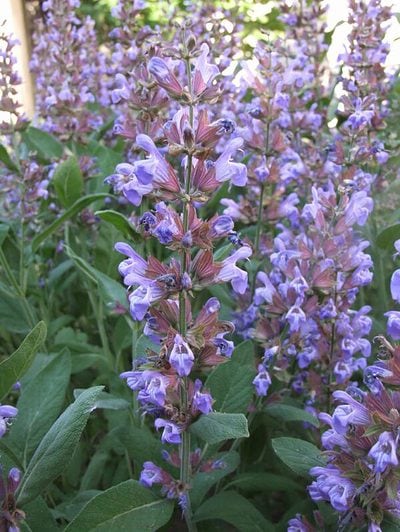The Herbs of Fulvicherb
The herbs of Fulvicherb together control the intestinal bacteria. Their module helps maintain a healthy, eubiotic intestinal flora condition and prevent the overgrowth of harmful intestinal bacteria. These herbs are tolerant to beneficial intestinal bacteria, and inhibit the growth of harmful intestinal bacteria. They prevent the development of Small intestinal bacterial overgrowth (SIBO). Also, they protect the stomach and intestinal mucosa and aid the production of digestive juices. They play an important role in regulating blood pressure and increasing urine excretion.
The composition of this herbal preparation, the use of fulvic acid as a chelating and complexing agent, the use of a fulvic acid–arginine complex and of special Praid salt containing ancient sea mud, and the entire manufacturing process, are covered under patent.
milk thistle - Silybum marianum
Silybum marianum, also known as milk thistle or St. Mary’s thistle, has been used for the treatment of liver disease, including hepatitis and prostatic cancer. This herb contains an array of lignans with anti-inflammatory and antifibrotic effects, improving the liver function.
The active ingredients of milk thistle are silymarin and water-soluble flavonoids (quercetin and taxifolin) that synergise with the former to protect the cytochrome p450 enzyme system. These ingredients play an important role in detoxification, and break down harmful fungal toxins, xenobiotics, and pesticides. Glyphosate damages this enzyme system, which has an important role in the basic regulation of the body’s metabolism and in maintaining a healthy hormonal balance. The active ingredients in milk thistle protect and regenerate the liver and the epithelial cells of the renal tubules.
Fulvicherb contains a milk thistle module, including a GMO-free and phytoestrogen-free sunflower lecithin, which helps absorb oily extracts such as silymarin.
Family: daisy family.
chamomile - Matricaria recutita
Matricaria recutita, commonly known as Chamomile, has remarkable anti-inflammatory effect. This herb has been approved to treat a wreath of diseases, including infection, bronchitis, fevers, and wounds. Also, it is a remedy for digestive conditions, period pain, toothache, vertigo, and headaches. Matricaria recutita is thought to aid in better sleep and the improvement of respiration, so it is typically served as a mono-herb for brewing, in the form of inflorescences.
Matricaria recutita has positive effects on gastritis (inflammation of the stomach lining), enterocolitis (inflammation of the digestive tract) and colitis (inflammation of the inner lining of the colon). As a supplement to the basic therapy, this plant is used to treat patients with ulcer (ulcus ventriculi or ulcus duodeni) (Rácz, Rácz-Kotilla, Szabó, (2012)). It protects the stomach and the intestinal mucosa.
The flowers of Anthodium chamomillae are used medicinally. They contain two groups of active ingredients:
· Sesquiterpene hydrocarbon (chamazulene): essential oils with anti-inflammatory effects.
· Sesquiterpene alcohol (bisabolol): non-volatile flavonoids.
The aqueous solution of chamomile flowers reduces the body’s sensitivity to histamine. Also, due to this property, it efficiently remedies secretory diarrhoea.
Family: composite family Asteraceae.
European Blueberry - Vaccinium myrtillus
Vaccinium myrtillus, also known as European Blueberry, has an edible fruit of blue or purple colour, which, together with its leaf, has been used in traditional medicine for nearly 1,000 years. Due to the high concentrations of its nutrients, potassium, and vitamin C, Vaccinium myrtillus has various health benefits. It helps prevent heart disease, regulates blood sugar, and maintains eye health. Also, it improves endothelial function in old age.
In the Carpathian Basin, this fruit is native to the Carpathian Mountains in Romania-Transylvania and Slovakia. Its leaves and green shoots contain catechol tannins and pro- anthocyanins. Due to the antibiotic properties of tannins, it is also used to treat diarrhoea (Rácz, Rácz-Kotilla, Szabó, 2012).
The antibacterial effect of blueberry has also been demonstrated on E. coli, Salmonella sp., Clostridium sp., Streptococcus sp., and Staphylococcus aureus.
Family: Ericaceae
dog rose - rosa canina
Rosa canina, also known as Dog rose, contains a high level of vitamin C, multiple times more than an orange. It is also rich in minerals, vitamin B, vitamin PP, and provitamin. Rosa canina has been used to treat asthenia, chronic diarrhea, colds, and throat inflammation.
Rose hips are a natural source of vitamin C and rutin (vitamin P) as well as a natural immune system booster. Vitamin C and rutin together are responsible for maintaining the structural integrity of connective tissues and are particularly important in maintaining the connective tissue structure of blood vessel walls.
Vitamin C is a synergist of silymarin (the active ingredient of milk thistle) and therefore we added a naturally occurring vitamin C to Fulvicherb, extracted from rose hips.
They have a mild diuretic effect.
Consuming rose hips is also recommended for people with diabetes due to the blood glucose regulating effect of rose hips.
Family: Rosaceae
Stinging Nettle - Urtica dioica
Urtica dioica, also known as Common nettle, or Stinging nettle, contains a wreath of nutrients which have positive physiological effects on the human body. This herb supports blood circulation, helps detoxication, improves kidney health and the health of the prostate as well as feminine health, promotes gastrointestinal health, and more.
Nettle leaves contain chlorophyll, carotenoids, vitamins A, C, K, U, triterpenes, glucokinins, sterols, flavonoids (quercetin, kaempferol, isorhamnetin) and minerals.
Studies have been conducted to verify the anti-diarrheal and anti-inflammatory effects of quercetin. They showed that it is able to inhibit secretion from the intestinal wall (discharge of substances that are useful to the body into the extracellular or intercellular space) and the production of neurotransmitters (such as histamine, serotonin and prostaglandins) that cause inflammation. In light of the above, nettle’s quercetin content helps stop secretory diarrhoea, where it is not caused by a viral or bacterial infection.
The combined phytotherapeutic effect of Rumex acetosa L. and Urtica dioica L. was studied by Davidović, M. Joksimović Todorović, B. Stojanović and R. Relić V. (2012) Test results showed that both herbs have excellent anti-inflammatory and anti-diarrheal effects.
Broad - leaved sorrel - rumex acetosa

Rumex acetosa, also known as Broad-leaved sorrel, has edible leaves when young but toughens with age.
It contains an array of important micronutrients, such as vitamin C, a key antioxidant that helps the body fight infection.
Another essential nutrient of Rumex acetosa is vitamin A, a fat-soluble vitamin that supports eye health, immune function, and reproductive health.
Its fruit has been used in folk medicine for centuries as a natural remedy for diarrhoea in humans and animals.
Dr. Andor Oláh, one of the founders and president of the Scientific Association of Hungarian Alternative Medicine Practitioners and Life Reformers, worked in Békés County in the ‘50s and ‘60s. In his 1985 book entitled “Fűbe-fába az orvosság!: Békés megye népi orvoslása” (Medicinal Plants and Herbs: The Folk Medicine of Békés County), he provides 10 references as to how to use Rumex acetosa L., commonly known as field sorrel, to treat diarrhoea in humans and animals.
Rumex acetosa L. is the most important herb in the supplementary therapy of Crohn’s disease.
Cluj-Napoca-based pharmacologists Z. Kisgyörgy and M. Péter (1982) were engaged in pharmacognosy and studied the effects of the species in the genus Rumex commonly used in folk medicine. Their anti-diarrheal effect has also been confirmed through experiments.
A similar conclusion was drawn by Rácz, Rácz-Kotilla, and Szabó (2012), namely that Rumex acetosa L. does not affect the beneficial species and strains of bacteria within the gut microbiome, and its inhibiting effect on the development of enterobacteria has been experimentally proven. The extract of the fruit of the Rumex spp. has been proven to inhibit bacterial growth (Bernáth et al., 2001).
Serotonin-induced secretory diarrhoea was inhibited by a drug obtained from Rumex maritimus (Rouf et al., 2003).
Yineger et al. (2007) noted that Far Eastern medicine uses species of the Rumex genus against Clostridium sp.
The drug obtained from the fruit of sorrel (Rumicis fructus) contains herbal flavonoids, quercetin, vitexin, rutin, other polyphenols and tannin. Furthermore, it contains astringent agents suitable for the treatment of diarrhoea and intestinal inflammation and tanning agents that create a film on the surface of the mucosa and reduce local stimuli, protecting the intestinal mucosa from the adhesion of harmful enterobacteria. These substances inhibit bacterial growth by damaging their cell membrane (Rácz, Rácz-Kotilla, Szabó, 2012).
Sage - Salvia officinalis
Salvia officinalis, also known as the Common Sage or Sage, is rich in nutrients. With its high-level antioxidant and anti-inflammatory compounds, Salvia officinalis has anticancer properties, promotes oral health, and provides the benefits of wound healing.
The dried leaves of this plant contain essential oils, diterpene carboxylic acids, polyphenols and rosmarinic acid. Pharmacological action: it contains an astringent substance (carnosol, also known as picrosalvin) that reduces inflammation of the mucous membranes, and has anti-diarrheal and antibiotic effects.
Poracova, Taylorova, and Salamon (2009) studied the anti-microbial and anti- diarrheal effects of common sage at the universities of Nitra and Prešov. Phytotherapy had a positive antimicrobial effect, resulting in a significant reduction in the number of harmful enterobacteria in the intestinal contents.

Fennel - Foeniculum vulgare
Foeniculum vulgare, also known as Fennel, has antibacterial properties and is rich in nutrients, such as B vitamins and dietary minerals, including calcium, iron, magnesium, and manganese. Foeniculum vulgare supports a healthy heart, a healthy blood cell formation, weight management, and helps reduce inflammation.
The achene of fennel, which contains 3–7% essential oils, is used medicinally. Its active ingredient is anthenol, and it also contains fencon and methyl chavicol. Sweet fennel has a mild antispasmodic and antibacterial effect in the urinary tract and increases the formation of protective urinary colloids (Rácz, Rácz-Kotilla, Szabó, 2012).
Fennel and anise fruit increase urinary excretion; the active ingredients of their essential oils have an inhibitory effect on bacterial growth in the urinary tract and prevent the formation of kidney stones. They also support the production of digestive juices.
anise - pimpinella anisum

The main use of anise in traditional European herbal medicine was for its carminative effect (reducing flatulence), as noted by John Gerard in his Great Herball, an early encyclopedia of herbal medicine:
“The seed wasteth and consumeth winde, and is good against belchings and upbraidings of the stomach, alaieth gripings of the belly, provoketh urine gently, maketh abundance of milke, and stirreth up bodily lust: it staieth the laske (diarrhea), and also the white flux (leukorrhea) in women.”
According to Pliny the Elder, anise was used as a cure for sleeplessness, chewed with alexanders and a little honey in the morning to freshen the breath, and, when mixed with wine, as a remedy for asp bites.
In 19th-century medicine, anise was prepared as aqua anisi (“Water of Anise”) in doses of an ounce or more and as spiritus anisi (“Spirit of Anise”) in doses of 5–20 minims.
In Turkish folk medicine, its seeds have been used as an appetite stimulant, tranquilizer, or diuretic.
The plant’s schizocarp (diachaenium) is used medicinally. The effects of anise’s active ingredient are similar to those of fennel, and they mutually reinforce one another (i.e. synergise with one another). Its active ingredient is an essential oil (3.0- 6.0%) containing 80-90% anethole and estragole (or methyl chavicol). This active substance is also excreted in the respiratory and excretory systems.
Anise has an effect on the gastrointestinal tract. It inhibits the growth of harmful bacteria, helps the secretion of digestive juices, and increases appetite (Rácz, Rácz-Kotilla, Szabó 2012).




